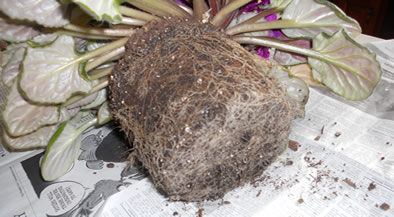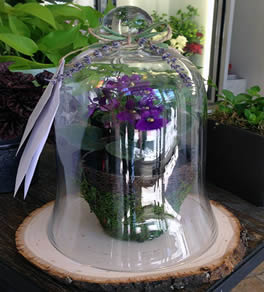In this article I cover everything connected to repotting an African violet. I will show you how to tell if your African violets need to be repotted, when the best time is to repot an African violet and I also outline the exact steps you need to take to repot your African violet.
Table of Contents
4 Essential tips for repotting African violet
Before we begin you should realise that an African violet is not actually a violet. African violets are distinctly different from violets and a lot of mistakes are made in the care of this little planet because owners confuse the two species. This includes the repotting of the plant.
I outlined in the article everything you need to know about African violets exactly what this plant type is and how it differs from the violet. For more information about the basic care needs of this plant you should read that article.
Below are detailed instructions for knowing when an African violet plant needs to be repotted. I also outline the best time to repot African violets and the exact process you need to follow to repot these beautiful flowering plants.
The best time of year to repot an African violet
There is no specific time of the year that is best to repot an African violet. African violets need repotted when the roots are growing out and around the rootball. When an African violet becomes root bound it needs to be repotted. As a general rule-of-thumb you should repot an African violet at least once per year.
I have read on several websites that you should repot an African violet twice per year. This is completely unnecessary. As long you you are using an adequate sized pot then once per year is more than sufficient for repotting.
In fact, the Royal Horticultural Society suggest you only need to repot African violets every two to three years. Personally I think this is a little on the conservative side and if you wait that long you will likely end up with a heavily root bound plant.

In the image above you can see an African violet plant that is root bound. The roots are bunched together at the base of the soil. In a case such as this you need to prune the roots.
The simplest way is to remove about 1/4 of the lower part of the soil with a sharp knife.
If the root bound is particularly bad you may also want to slice thin layers away from the sides as well.
When I repot my African violets
Because African violets are mostly grown as houseplants in the US they have a fairly consistent localized climate. Unlike garden plants that must be tended to according to the season, we can be much more flexible when it comes to houseplants.
Although you can repot an African violet any time I will repot mine in spring every year. This helps me maintain a consistent repotting schedule, ensuring the plants get reported every year, while putting the least amount of stress on the plant due to the fair temperature conditions.
Identifying when it’s time to repot your African violets
I often get asked by African violet houseplant owners when they should repot their plant.
You should repot an African violet at least once per year. African violets tend to get root bound and contrary to popular opinion they not like to stay that way. So as a rule-of-thumb repot your plant once per year. I repot African violets in spring.
African violet roots grow outward rather than downward and so they can outgrow their pot fairly quickly compared to other houseplants. This means African violets require regular repotting.
Repotting an African violet plant once per year is more than enough. Even though many owners will repot their African violets twice per year this is totally unnecessary. Once per year is all you needs to ensure the roots never become root bound.
The great thing about repotting African violets is that it also gives you the opportunity to divide the plant at the roots. This is the easiest way to propagate a new plant and get two or more plants from one.
There is no specific time of year that is best for repotting an African violet plant. Your repotting schedule will greatly depend on the growth of your plant. Even though I have heard houseplant gardeners state that African violets will happily grow when they are root bound this is not correct.
A root bound African violet will not die but it will not produce its best blooms (see our guide to African violet blooms) and it will never be a truly healthy plant. It really needs to be repotted regularly in order to give the roots a chance to grow and maintain good flow of water and nutrients to the foliage of the plant.
African violets also like airy soil and when they become root bound oxygen is severely restricted in the soil.
Root bound roots can also lead to water retention in the soil which will lead to rot root and dehydration in the foliage.
How to spot a rootbound African violet that needs repotting
So how do you know when an African violet plant has become root bound and needs to be repotted?
You know when an African violet needs repotted when they are root bound. The only definitive way to tell when this has happened is by removing the plant from its pot though you may see signs of faded foliage and flower colors. When root bound the soil will be compacted and held firmly in shape by the roots with lots of roots entangled at the base.
Contrary to what many online gardening enthusiasts and houseplant lovers say, an African violet does not like to be root bound!
Root bound African violets will produce lack luster foliage and will eventually stop blooming or only produce limited blooms for a few months each year instead of continuously.
A healthy African violet will bloom at least 10 months of the year and a well-cared for plant will usually bloom continuously throughout the year for the full 12 months.
When you aim for a repotting schedule of once per year you can avoid foliage and bloom problems.
You will have happy plants that continually bloom through the year – this is of course as long as your watering care is correct and the plant is getting the correct amount of, and correct type of, light.
How to repot an African violet the right way
Below are the simple steps you should follow to repot an African violet plant.
Important considerations before repotting:
- Make sure you have the correct soil for African violets. Houseplant soil and succulent soil is not acidic enough.
- Avoid using a deep pot. African violet roots grow outward, more than downward. With a deep pot there will be excessive unused soil at the bottom as the roots grow and take up space in the upper part of the pot. This soil tends to hold onto to water. Although African violets can be propagated in water they do not like to sit in water so having drenched soil in an African violet pot means running the risk of drooping leaves and even rot root.
- You do not need a bigger pot when repotting an African violet. You can reuse the original pot with fresh soil, or better still, you can use a shallow wide pot, (like these), that will allow the African violet roots room to grow outward further reducing the risk of them becoming root bound.
- You may want to consider using a self-watering pot as these will ensure your plant not only gets the correct amount of water but it will also help to regulate the humidity levels around the African violet. I personally prefer terracotta pots because they look classy and also help to maintain good humidity levels compared to ceramic and other materials.
Once you have your soil and pot ready you can progress to repotting your African violet.
Step-by-step instructions for repotting an African violet
Follow the simple steps below to repot an African violet plant and you will eliminate the risk of shocking the plant and increase the chances of even healthier and more vibrant blooms.
The simple steps to repot an African violet:
- Add a little bit of soil to the bottom of the new pot. Just enough so the African violet plant will sit on top with its foliage above the sides of the pot. As you do require a bigger pot than the one the plant is currently in, it is unlikely you will need to put much soil into the new pot at this stage.
- Remove the African violet from its pot by carefully by gently gripping it below the foliage as far down the stems of the plant, and as close to the soil, as possible. Try to avoid manhandling the foliage as the leaves on this plant do not like to be touched (just one reason to keep kids and pets away from your African violets).
- You may need to push the bottom of the pot at the rootball to loosen the soil enough to release the plant. Obviously this is only possible if your African violet is in a plastic pot.
- If your plant is in a ceramic, terracotta or other hard pot then you may need to use a regular butter knife to loosen the soil around the inside diameter of the pot before trying to remove your plant.

- Once released from its pot you can gently rub at the bottom of the soil to free up the roots a little though this is not totally necessary unless there are signs the plant is root bound – it won’t be if you keep up a yearly repotting schedule.
- Set the plant into the pot.
- Use your hands to add more soil around the plant. Be very careful with the leaves and try to avoid handling them too much. You will probably need to move them slightly when adding the soil but just remain aware that the foliage of an African violet is delicate and rigid and the leaves do not like to move much. See our African violets leaves care guide.
- Once potted consider using a technique known as “tenting”. By using a tent (I use mini domes as they can be reused for winter gardening protection for my outdoor plants as well) you effectively build a mini-greenhouse around the African violet thus creating the ideal climate for quick and healthy growth. You can also use plastic grow bags though domes and mini-greenhouses allow you to still display your beautiful plants.
- After a week or two you can remove your repotted African violet from its tent and display it in its usual place.

Now you know how to repot an African violet and the reasons for repotting it you may be wondering if there is a specific time that is best to repot it.
So, you now know how to transplant an African violet by repotting it go get started!

